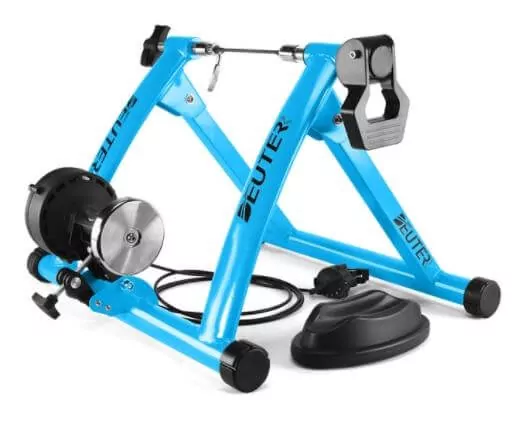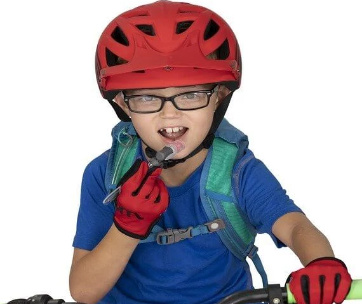We live in a fast-paced world where talent pays better. Cycling is one area of sports where people display their skills. One way of discovering and nurturing your kids' cycling talent is by getting them an indoor bike trainer.
While initially riding a bike trainer was a preserve for pro cyclists training for races, it has today evolved into a preferred way to tap into the benefits of cycling. It gives cyclists the confidence of at least having the bike pedaling experience, especially when bitterly cold, oppressively hot, and stormy weathers hit,
Whether you are training for a race, warming up your muscle pre-rides, or looking for an intelligent way to maintain the cycling fitness of your kids, bike trainers are a better idea.
Now, imagine it is winter or summer when the sun scorches. Wouldn’t it be fun having your kids extend their cycling on a kid-specific bike trainer? We thought it was a good idea. Therefore, this article will offer some insights on the types of indoor bike trainers and how to select the best.
Types of Bike Trainers to Consider for your Child
Trainers are proven to be an excellent platform for moderate to high-intensive aerobic workouts. Depending on your budget, you will get precision and fun in the feature-packed premium models. However, some basic indoor trainers do not cost much. The only difference between the premium-priced high-end bike trainers is that they are packed with immersive technology that allows the rider to simulate riding conditions.
To get a good bike trainer for your kid, you will have to part with a few hundred dollars. If you are after the mid- or high-end bike trainers that come with virtual simulation capabilities, prepare to fork out a few thousand dollars.
That said, we can categorize bike trainers by functionality and price.
In terms of functionality, bike trainers fall into three categories: wheel-on trainer, direct-drive trainer, and bike simulator trainer.
Wheel-On Bike trainers
These are solid yet affordable bike trainers that attach to the axle of the rear wheels of a bike. They use a roller that presses against the tire to create resistance. They are stationary, and the rider can adjust the level of resistance as they deem fit.
Pros
- Practical, simple, and efficient for beginner riders
- Less expensive compared to higher-end trainers
- Easy to mount and unmount
- Compatible with most kids’ bikes
- It easily folds up for easier storage
- High-end models allow app connectivity
Cons
- Quality, quiet, and smooth rides are not guaranteed
- It causes wear and tears on the wheels. You will need to have an extra tire and wheels for exclusive use on the trainer.
- Budget models do not come with app connectivity. Still, you can modify it through DIY to achieve some extent of monitoring and simulation. Just purchase sensors (heart rate, speed, and cadence) and bike computers, and you are good to go.
Direct-drive Trainers
The direct-drive bike trainers allow you to attach your chain and derailleur to the mechanism. Unfortunately, this means that you have to remove the rear wheel of the bike. However, they have the advantage of smooth power transfer. They also allow for app connectivity, making them slightly costly but worth the price for someone who knows.
Pros
- It simulates the feel of cycling better than wheel-on trainers
- Better and quieter rides
- Great resistance control
- Efficient power transfer
- Compatible with wireless app connectivity. You can use it on ZWIFT
Cons
- A little expensive compared to wheel-on trainers
- A complex set-up that might require purchasing a cassette that is compatible with the trainer
- It does not allow direct use of your bike, and the attachment and detachment process might be tiring
Bike-simulator trainers
Also referred to as stationary bikes, this category of indoor bike trainers refers to premium standalone exercise bike that offers an immersive environment that mimics the feeling one has when cycling on a real bike. In addition, it comes with a stable, comfortable, and robust platform that allows you to connect wirelessly to apps.
Even the most affordable models of bike simulators rival high-end smart trainers in price. Without connectivity, the bikes are much similar to the stationary bikes at the gym.
They are very stable, thus a good choice for kids who do aggressive cycling. They can endure hard workouts. They are also a good choice for kids who do a lot of indoor cycling as they do not need a bike to operate. However, their bulky nature makes them take up more space. You might need a dedicated spot for a home training area.
Pros
- The more premium you choose to go, the more immersive and interesting the simulation gets. You get to experience quieter rides and more app connectivity
- Has durable builds
- It is tuned well for ergonomics and allows for necessary adjustments for multiple riders
- You do not have to dismantle and use your bike on it
Cons
- The prices are on the roof but all for premium features and performance
- It might require a dedicated room for training due to heavy-duty builds
Word on smart trainers: start trainer is a feature and not a class we can categorize bike trainers. It refers to the ability of an indoor-bike trainer to allow the connection of cycling apps. The sensors that come with the smart trainers can change resistance to match the topography the rider wants. These software-controlled smart trainers create virtual workout conditions that simulate real-world cycling terrains. You can also get feedback and performance metrics, which can be used to plan and improve training efficiency. There are also gamification features that can be addictive but fun. Trainers with smart features can allow kids to compete with others in specific apps such as Zwift, Sufferfest, Rouvy, Strava, and BKool.
Factors to Consider when Purchasing a Bike Trainer for Your Kid
If you are shopping for a good indoor bike trainer for your kid, here are some specifics that you need to consider.
Type of Bike Trainer
As discussed, there are different types of bike trainers, each with its unique pros and cons. When selecting the trainers, choose them based on the advantages and disadvantages then depending on the price levels. Go for what you can manage in terms of price and use/storage space.
Price
Your budget for an indoor bike trainer matters a lot when choosing one. If you are cash-strapped but want a trainer, save for the basic wheel-on trainers as they only cost a few hundred. There are mid-range and high-end wheel-on indoor bike trainers too. The direct-drive indoor trainer models, while giving you the best experience, cost a little more. The bike simulators are now even far expensive indoor bike trainers.
Connectivity
When shopping for a good bike trainer for the indoors, consider the price and the app connectivity alternatives it gives you. Most people value real-time workout feedback, virtual simulations, social riding features, and a hoard of other interactive features. If a trainer allows wireless connectivity to the training apps and meets your budget, get it for your kid.
Space
You also need to consider the training space you have in your house. Equally, consider the storage space in your garage. The wheel-on and direct-drive indoor trainers allow some portability and require little space. However, the bike simulators will require you to set up space for a home workout studio, given that they are bulky. Packing and transporting the basic wheel-on bike trainers is also far easier than direct-drive and bike simulator trainers.
Bike Compatibility or fit
Although trainers can fit most bikes, the range of 24” to 29”, you might be required to invest a few more dollars on accessories to prepare your regular bike to be indoor bike trainer compatible or fit. For example, you might need a new cassette or chain to make it work on the trainer. Check the specs of the trainer and those of your bike to be sure that you are purchasing a trainer your kids will eventually use when assembled.
Noise
Even though trainers have gotten quieter over the years, you need to be sure about the amount of sound produced by the trainer, primarily measured in decibels. Check the amount of sound at different speeds and conclude whether it is the best for your kid. If you feel the kid might be affected, you can buy protective ear aids. Sound is produced mainly on the drive train of the bike and the contact points between the trainer and the tires, as is the case with wheel-on bike trainers.
Intangibles
Check for after-sales services such as customer support, installation guides/videos, and warranties before purchasing a bike trainer. They are already an expensive investment, and you want to make sure that everything is in place in case the worst happens.
Accessories
The accessories include seat mats for floor protection, headwind and tailwind simulators, and unique platforms that mimic the movement of a bike in different outdoor environments. You can also check whether you need heart rate monitors, speed and cadence sensors, bike computers, cycling apps, screens/laptops, towels, pedals, shoes, etc.
Type of Resistance
There are different mechanisms used to create resistance in indoor bike trainers. In the good old days, buying a trainer would depend on what type of resistance it produces. However, in the most efficient wheel-on bike trainers, you’d prefer the fluid resistance for its smooth and quiet operation.
Today, the focus has shifted on connectivity and app range. The easier it is to connect an indoor-bike trainer to wireless apps, the better. The electronically-controlled smart trainers come with mechanisms that allow you to set resistance by choosing settings on the compatible apps.
Applications
Bike trainers are compatible with a range of third-party apps that allows the users to monitor their performance and efficiency while on the trainer. Although trainers such as Elite, Wahoo, Tacx, and many others have their dedicated training platforms that offer workout plans and virtual training challenges/environments, their content might be limiting. So, it is good to check whether the smart trainer allows you to connect to independent platforms that offer exciting and rich virtual cycling environments, more workout challenges, and a larger community of users for social rides/competition. Also, check whether your kid is into gamified experience or workout programs as well and get them a trainer that matches their desires.
Parting Shot!
With the advancement in sports tech, indoor bike trainers have transformed from the basic rollers through wheel-on and direct-drive trainers and now to bike simulators. Although expensive, these indoor bike trainers are worth their price.
If your child has made peace that they want to pursue cycling as a profession in the future, why not give them a chance by purchasing a suitable kid-friendly bike trainer?
These trainers extend the days of cycling. When it is too cold, hot, or snowy to ride, the kids can burn calories and build muscles for competition or to keep fit indoors.
And being that they used indoors, the kids can ride when listening to their favorite music or watching the world bike tour/competition videos. They are also a safer means of getting to experience the benefits of cycling. There are no chances of being driven to the edge of the road by rogue drivers. So it is much safer for the kids.
One more thing, the kids can learn how to pedal using the indoor bike trainers. Since these a limited to 24–29-inch wheels, you can modify a kid’s bike with training wheels by lifting the training wheels with a book, shoe, or whatever and stabilizing them so the kid can pedal and the rear wheels roll unhindered.






Comments